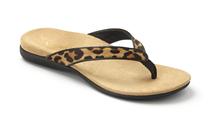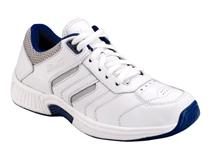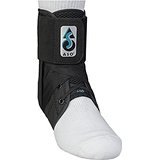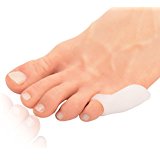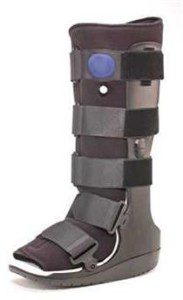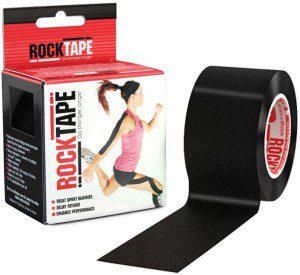Pain on the outside of the foot (side of the pinky toe) is a common problem we treat in our Seattle foot and ankle clinic. In most cases outside of the foot pain responds well to treatment.
Call 206.344.3808 or use our Patient Portal to schedule an appointment for an evaluation and treatment recommendations.
If you cannot visit us at our Seattle clinic, you can find self-treatment suggestions for pain on the outside of the foot at the bottom of this page.
Self-Treatment of Pain on the Outside of the Foot
If you cannot visit us in our Seattle clinic, you can find self-treatment suggestions below.
If the outside of your foot hurts, it is usually due to one of about 8 different conditions that affect the outside of the foot near the 5th metatarsal (long bone behind little toe) bone. Sometimes the pain is found a bit more on top of the foot.
Causes of Pain on the Outside of the Foot
Listed below are the most common causes of pain on the outside of the foot. Use the links to read more and learn how to best treat pain in this area (remember you should see a physician to accurately diagnosis your problem). A fracture of the long bone behind your little toe (5th metatarsal) in particular can be very serious and resistant to healing so make sure you don’t delay your diagnosis. Use the links below and follow the instructions we give for treating these problems (continued after video).
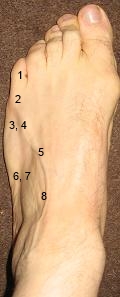
Where is Your Outside of Foot Pain?
Some of the common causes of pain on the outside of your foot are listed below in order from problems close to the toe heading back toward the heel. Use the links to find detailed diagnosis and treatment information on each problem:
1. 5th Toe (baby toe) Hammertoe – A curled pinky toe often results in shoe pressure that leads to pain and possibly the formation of corns. Treatment goals include reducing pressure on the painful portion of the toe through the use of pads, shoe changes, lacing changes and more. Detailed treatment options are available at the link above. Use the link to learn how hammertoe pain can be eliminated.
2. Tailor’s Bunion – A Tailor’s bunion (or “bunionette”) is bump on the side of foot at the head of the 5th metatarsal bone (just behind the little toe). Tailor’s bunions can become painful and inflamed when the enlarged bone gets pressed on by your shoes. There are a number of available treatments including surgery – but surgery should always be used only as a very last resort. Our initial treatments are focused on reducing pressure on this area and stabilizing the foot to prevent splay that increases pressure on the bunionette.
3. Metatarsal Stress Fracture – A tiny fracture through the outside of the bone caused by overuse rather than acute trauma. More common on the 2nd and 3rd metatarsals but can occur in the 5th metatarsal on the outside of the foot also. Swelling is common as is very localized pain when you press on the metatarsal bone. Treatment should be initiated as soon as possible to prevent the fracture from getting worse. You can learn about the most effective treatments in our Guide to Metatarsal Stress Fractures.
4. 5th Metatarsal Shaft Fracture – There are several types of fractures that can affect the 5th metatarsal. Some heal with just a walking boot and others almost always require surgery. A specific type of 5th metatarsal fracture called a “Jones fracture” can be a very serious fracture that may require non-weightbearing or surgery to heal. If you have any suspicion that you might have fractured this bone get it treated immediately. Learn more here about fifth metatarsal fractures.
5. Dorsal Compression Syndrome – Achy pain with activity that is more toward the top of the foot, rather than the side. Often due to flattening of the arch causing compression between the bones. This condition responds very well to conservative treatment focused on supporting the arch. Using better shoes and arch supports is often a cure. Use the link to learn about “dorsal compression syndrome“.
6. 5th Metatarsal Tuberosity Fracture – A break of the very base of the 5th metatarsal bone. Often occurs after twisting your ankle. If the base of your 5th metatarsal is painful after an ankle sprain you’ll need an x-ray. In fact, one of the primary reasons we get xrays following an ankle sprain is to check the base of the fifth metatarsal. If you sprain your ankle and you hurt at “number 6” in the above picture, see us immediately if you are in the Seattle area. If you are outside Seattle see a sports medicine podiatrist near you. Learn more at the link above.
7. Peroneal Tendonitis – The most common cause of outside of foot pain. Caused by inflammation where the peroneus brevis tendon attaches into the base of the 5th metatarsal. Usually responds rapidly to proper treatment. Treatment is focused initially on reducing tension on the peroneal tendon through the use of proper shoes, arch supports, taping, ankle braces and/or walking boot. After it has calmed down we focus on strengthening the tendon Learn more (including home treatment options) in our Guide to Peroneal Tendonitis
8. Foot Arthritis – Often causes a deep achy pain sensation on top of the foot just in front of the ankle. Caused by a wearing away of the cartilage between the joints on the side and top of the foot. Most foot arthritis can be treated without surgery by using proper orthotics and shoes to limit motion in arthritic joints. We will also often use foot strengthening exercises to limit painful foot motion. Learn home and professional treatment options in our Guide to Foot Arthritis.
Self-Treatment of Pain on the Outside of the Feet
First, for the best solutions to the specific problems listed above use the links to those pages. There are, however, some general things that you can do to help relieve pain on the outside of the foot. Try the solutions below for about 3 weeks. If you are not yet better, see a podiatrist. These are the products we recommend to our patients (and our families) and they are also affiliate links so we may receive a small commission at no additional cost to you if your order from the link.
1. Use high quality arch supports to transfer pressure off of the outside of the foot to the inside of the foot.
This is the most important treatment you can do because it reduces the forces that cause the pain.
We recommend the FootChair Adjustable Orthotics for athletic shoes and other lace up shoes. These are our 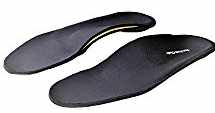 favorite OTC arch supports as they have pads you can add to increase the arch height. By being able to adjust the arch height you are able to transfer as much pressure as possible off of the outside of the foot.
favorite OTC arch supports as they have pads you can add to increase the arch height. By being able to adjust the arch height you are able to transfer as much pressure as possible off of the outside of the foot.
For smaller shoes (like casual women’s shoes, soccer cleats or high heels) you can use the FootChair Slim Adjustable Orthotic. 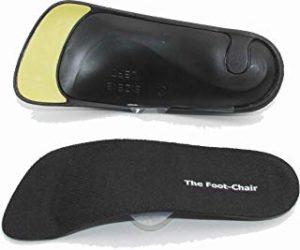 These have the same adjustable arch like the full size FootChair but they fit in smallershoes. They do not have a full length cover so they fit better into shoes with a smaller toebox.
These have the same adjustable arch like the full size FootChair but they fit in smallershoes. They do not have a full length cover so they fit better into shoes with a smaller toebox.
For women’s high heels and flats (including ballet flats) we again recommend the FootChair Slim dress orthotic. This is the smallest OTC arch support we have found that will still provide adequate support to decrease pressure on the outside of the foot.
2. Use Arch Support Sandals to Transfer Pressure off of the Outside of Your Feet
When you are not wearing shoes wear Vionic flip flops, sandals or slippers. Vionic sandals and slippers have exceptional arch support and will transfer pressure off of the outside of the foot onto the mid-arch area. There are many styles and all of them have this great arch support.
3. Use Very Supportive Shoes
Download our list of recommended shoes to find the best shoes for your feet. We update the list regularly. If you don’t have a good shoe store nearby, these Orthofeet Shoes for Women and Orthofeet Shoes for Men provide great support.
4. Ice your foot for 10 minutes 3 times each day.
5. Wear an Ankle Brace if you have Peroneal Tendonitis
One of the more common types of pain on the outside of the foot is peroneal tendonitis. If you have pain in your peroneal tendons then using an ankle brace will help reduce tension on the peroneal tendons to allow healing. We often recommend the ASO Ankle Stabilizer as it is a quality brace with excellent lateral support at a very good price.
6. Pad the Tailors Bunion and Separate the Toes 
If you have a bump on the outside of your foot below your little toe, this silicone Tailor’s Bunion pad offers great protection and pain relief and, unlike many of the pads we have seen, will stay in place inside your shoe.
There are a number of these pads on the market. This is our favorite because it both protects the tailors bunion and provides a bit of separation between the 4th and 5th toes. And it is priced very well – this package comes with 4 pads and is usually less than $12.
7. Stretch your Shoes
If you have a tailor’s bunion bump on the outside of your foot and your shoe is pressing on it too hard and causing pain, you can stretch your shoe in this area. The easiest way is to use a “ball and ring shoe stretcher“. These inexpensive devices make it easy to stretch shoes over a bump like a tailor’s bunion.
too hard and causing pain, you can stretch your shoe in this area. The easiest way is to use a “ball and ring shoe stretcher“. These inexpensive devices make it easy to stretch shoes over a bump like a tailor’s bunion.
8. Wear a Walking Boot
If you continue to have pain, see a podiatrist. While waiting for your appointment protect your foot by wearing a walking boot. A walking boot offers the best possible protection while still allowing you to bear weight.
Don’t live with pain on the outside of your foot. Call 206.344.3808 or use our Patient Portal to schedule an appointment for an evaluation and treatment recommendations.
Taping for Pain on the Outside of the Foot
One of the most common causes of pain on the outside of the foot is peroneal tendonitis. A simple taping that you can do yourself can often reduce tension on the peroneal tendon enough to relieve pain, at least temporarily. This video shows proper technique for taping for peroneal tendon pain. We recommend using Rocktape kinesiology tape as it almost never causes skin irritation and can be left on for several days.





